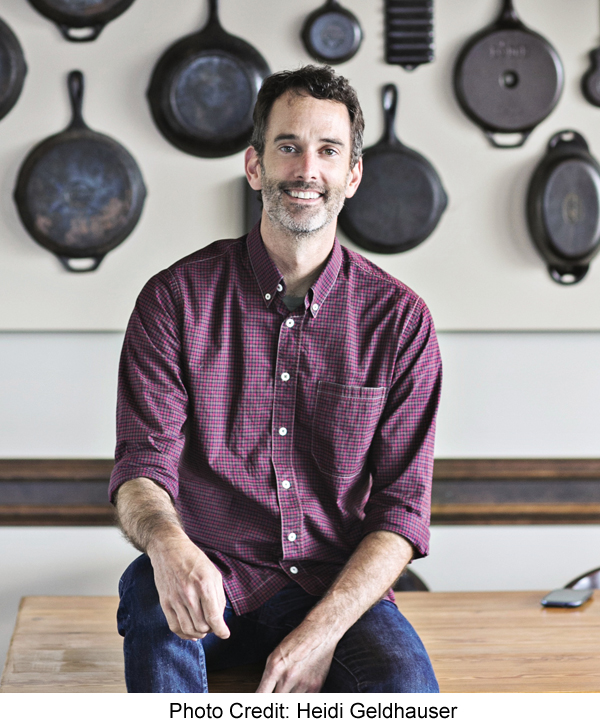Share This
We were hooked before we saw his book.
During FNCE 2014 the Oldways team made a beeline to Miller Union in Atlanta to sample Chef Steven Satterfield’s delicious southern food, highlighted by the elegant way he shines a spotlight, in dish after dish, on seasonal vegetables. A savvy cook who cares as much about sourcing fresh food as he does about not wasting it, Satterfield’s innovations seek ways to use every part of a vegetable. His beautiful new book for omnivores, Root to Leaf, offers plenty of fresh, new ideas and stunning photos that will send you scurrying into the kitchen.
We caught up with Chef Steven late last month to learn more about his thoughts on regional cooking within Atlanta’s progressive culinary community.
OLDWAYS: In the introduction to Root to Leaf, you mention your struggle with cancer and your reliance on farm-fresh nutrition, herbs, and probiotics to support your recovery. Can you tell us a bit more about how your relationship with food changed or developed during this time?
STEVEN: I would say that my relationship with food has always been strong from the point of desire and pleasure, but during this time it skewed more towards need. I knew that my body was being poisoned by chemotherapy, and I felt like the best way to counteract the toxicity was to eat clean food: fruits and vegetables and lots of them.
OLDWAYS: You refer to root-to-leaf cooking in the book and share ideas for using chard stems and the leaves of Brussels sprouts, as two examples. When did you begin to think about using all (or more) parts of fresh vegetables? Can you share a few more examples of how we can apply this idea to our home cooking?
STEVEN: I am always thinking of new ways to divert waste. For instance, we use cilantro stems thinly sliced in a dish that will be garnished with cilantro, or vegetable scraps like leek tops, turnip stems, or vegetable peelings in stocks or soups. Carrot tops or radish greens may end up in a pistou or an herb sauce, etc.
OLDWAYS: How does your location in Atlanta (and the South) offer unique opportunities to work with a network of local food purveyors?
STEVEN: We are surrounded by rural areas and the city is very verdant, so just about anything will grow here unless it requires cold temperatures or an arid climate. There are so many farms on all sides of the city and our farmer’s market scene is booming.
OLDWAYS: Many of your recipes, such as those for turnip greens and for chard, rely on very quick cooking, just until the leaves are wilted. Why do you think so many traditional Southern recipes for greens and other vegetables call for much longer cooking times?
STEVEN: Chard and young turnips do not require long cook times; their leaves are more delicate and tenderize quickly. I think mature turnip greens or collard greens are best when slow simmered. They take on a different quality when they are cooked that long, and the resulting broth, or pot likker as we call it, is incredible, almost a tonic. That being said, Root to Leaf is more about exploring the fresh flavors of the New South and less about traditional southern cooking. I definitely like a mix of the two, as I think it is important to carry on food traditions while exploring new ones.
OLDWAYS: A number of recipes in your book, such as English or Field Pea Hummus, Eggplant and Peanut Baba Ghanoush – offer a Southern twist on Mediterranean favorites. Have you been inspired to play with ideas from any other cultures?
STEVEN: Absolutely. I think Italian and Mediterranean flavors work really well with southern produce and the approach is similar. Take fresh ingredients and do very little to them, but add lots of flavor.
OLDWAYS: Since finishing your book, what new things have you been experimenting with in your kitchen?
STEVEN: I’m always exploring different ways to cut or cook vegetables. Lately a few experiments include cutting summer squash into long think strands and cooking it like pasta; grilling okra with peanut oil and serving it with crushed peanuts, cumin, yogurt, and mint.
OLDWAYS: We want to try so many of your recipes! May we have your permission to include the recipe for Pears Poached in White Wine and Rosemary?
STEVEN: Yes.
Pears Poached in White Wine and Rosemary
Here’s an easy way to put up a bumper crop of pears without pulling out the canning equipment. Depending on the size, ripeness, and variety of the pears, they may take more or less time to cook, so keep an eye on them in the pot. Serve with cheese, as a component of a dessert, or sliced in a salad. Piney, evergreen rosemary imparts an intriguing overtone.
8 servings
Ingredients:
1 bottle medium-dry white wine
2 cups sugar
6 sprigs rosemary
Pinch salt
4 firm ripe pears
Directions:
In a large saucepan, combine the wine, sugar, rosemary, and salt. Slice each pear vertically into equal quarters. Place each quarter cut side down, with the seeds facing your knife. With the blade at a 45-degree angle, slice away the core and seeds from each quarter. Add the pear quarters to the pan. Simmer over medium-low heat until the pears become just tender with a hint of translucence, but still retain their shape, 30 to 40 minutes. With a slotted spoon, carefully remove the pears from the liquid, and cool them separately to stop the cooking. Discard the rosemary stems. Let the liquid cool slightly and then chill it in the refrigerator. Recombine when they are both completely cooled. Store covered in the refrigerator for up to 2 months.



Add a Comment